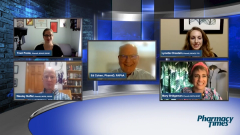
Novavax Emergence and Anticipating Patient Scrutiny Regarding Vaccines
Key opinion leaders discuss common narratives and concerns regarding a variety of vaccines and share successful strategies to overcome vaccine reluctance.
Episodes in this series

Wesley Nuffer, PharmD, BCPS, CDCES: We also have a newer vaccine that’s very close to being approved: the Novavax vaccine. That one is a recombinant. They basically provide protein that codes to the spike on the virus. By getting it into the cells, they also have an adjuvant that boosts your immune response. Basically, they use your body to make this protein and create an immune response to it. At the same time, they use the adjuvant to boost that immune response many times more than the natural immunity would have.
This isn’t new. It’s older technology than the ones we just talked about—especially the mRNA vaccines—which we hope will overcome some vaccine hesitancy. Some of the people I talked to were a little nervous about brand-new technology being rushed forward. In the field, we know that isn’t the case. It wasn’t rushed, but it did happen very quickly and it was very new technology, and people thought, “I just want to wait and see.” But some of these other technologies have been around for many years and are more established. Hopefully someone who may not want these newer vaccines might go to something like what Novavax has and say, “OK, I can use this product and have it safe.” I believe I misspoke in the fact that with this new virus, they aren’t encoding for it. They’re providing the virus inside of these nanoparticles so it exposes your body to it without having to be made by the body. That’s how this one is different.
Mary Bridgeman, PharmD, BCPS, BCGP: I wanted to piggyback onto that, Wes. It’s important to point out that as a protein-based vaccine, this fourth vaccine product against COVID-19 relies on the most traditional vaccine science among our available COVID-19 vaccines. As you pointed out, these protein-based vaccines aren’t new or novel. Vaccines like the shingles vaccine, Shingrix; the HPV [human papillomavirus] vaccine, Gardasil; and even our DTaP [diphtheria, tetanus, acellular pertussis] and tetanus vaccines use a similar technology.
For individuals who have been uncomfortable with the science or process behind the mRNA and adenovirus vector vaccines, this vaccine preparation might be more comfortable and an option that they might be amenable to receiving. I agree that this might be an option that may be amenable to individuals who’ve been holding out. I also think it’s important to be a little compassionate. I always try to support patients. It’s never too late to change your mind to become immunized. It’s important to support patients who waiver in the face of new information. I certainly want to support those decisions.
Ed Cohen, PharmD, FAPhA: For the Novavax vaccine, the older technology is a wonderful thing. However, when the FDA came out and was going toward their approval process, they added the cardiac effect. The recommendation was made, but it wasn’t as robust a recommendation—correct me if I misspeak here—as we had wanted or anticipated. Is that going to cloud some of this positive news?
Traci Poole, PharmD, BCACP, BCGP: There’s a possibility, especially as Mary and Lynette were saying. Patients are paying attention these days. The news is all over some of this stuff. Any time an adverse effect is found, no matter how small, it’s being reported and patients are becoming a little more leery, so I have some concern that with the warning, patients are going to be a less enthusiastic about getting it, even though it’s tried-and-true technology.
Mary Bridgeman, PharmD, BCPS, BCGP: It’s critical as pharmacists that we keep abreast [of new information] and see how this shakes out. As we look at and scrutinize these numbers, what’s the true incidence that we believe is occurring with use of this vaccine product? It’s certainly something to keep an eye on and a pulse on, as we’ve done throughout with the emergence of these new vaccines and technologies.
Transcript edited for clarity.
Newsletter
Stay informed on drug updates, treatment guidelines, and pharmacy practice trends—subscribe to Pharmacy Times for weekly clinical insights.

















































































































































































































